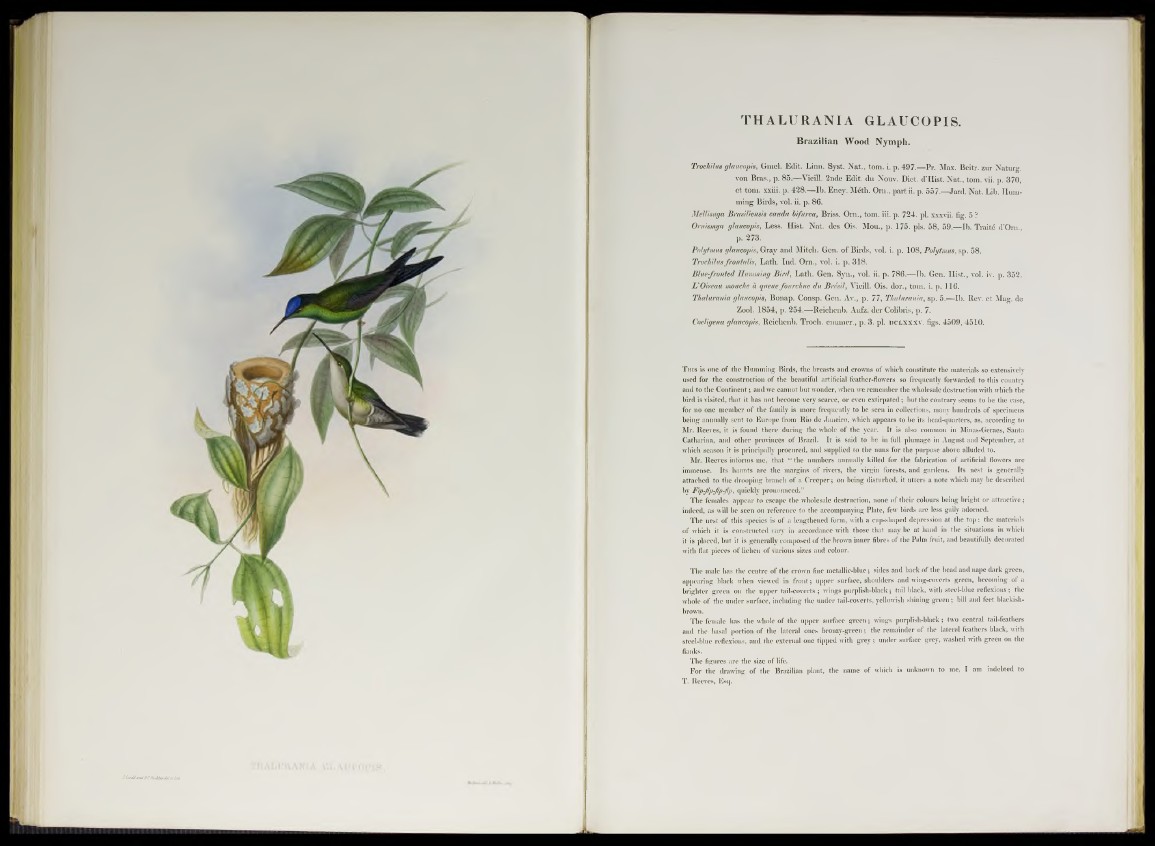
J. GoM rrnJJIC. IliJdrr, lid tl /itfi
THALURANIA GLAUCOPIS.
Brazilian Wood Nymph.
Trochilus glaucopis, Gmel. Edit. Linn. Syst. Nat., tom. i. p. 497.—Pr. Max. Beitr. zur Naturg.
von Bras., p. 85.—Vieill. 2nde Edit. du Nouv. Dict. d’Hist. Nat., tom. vii. p. 370,
et tom. xxiii. p. 428.—Ib. Ency. Méth. Om., partii. p. 557.—Jard. Nat. Lib. Hum-
ming Birds, vol. ii. p. 86.
Mellisuga Brasiliensis cauda bifurca, Briss. Om., tom. iii. p. 724. pl. xxxvii. fig. 5 ?
Ornismya glaucopis, Less. Hist. Nat. des Ois. Mou., p. 175. pis. 58, 59.—Ib. Traité d’Om.,
p. 273.
Polytmus glaucopis, Gray and Mitch. Gen. of Birds, vol. i. p. 108, Polytmus, sp. 58.
Trochilus frontalis, Lath. Ind. Om., vol. i. p. 318.
Blue-fronted Humming Bird, Lath. Gen. Syn., vol. ii. p. 786.—Ib. Gen. Hist., vol. iv. p. 352.
L'Oiseau mouche d queue fourchue du Brésïl, Vieill. Ois. dor., tom. i. p. 116.
Thalurania glaucopis, Bonap. Consp. Gen. Av., p. 77, Thalurania, sp. 5.—Ib. Rev. et Mag. de
Zool. 1854, p. 254.—Reichenb. Aufzi der Colibris, p. 7.
Coeligena glaucopis, Reichenb. Troch. enumer., p. 3. pl. d c l x x x v . figs. 4509, 4510.
T his is one of the Humming Birds, the breasts and crowns of which constitute the materials so extensively
used for the construction of the beautiful artificial feather-flowers so frequently forwarded to this country
and to the Continent; and we cannot but wonder, when we remember the Wholesale destruction with which the
bird is visited, that it has not become very scarce, or even extirpated; but the contrary seems to be the case,
for no one member of the family is more frequently to be seen in collections, many hundreds of specimens
being annually sent to Europe from Rio de Janeiro, which appears to be its head-quarters, as, according to
Mr. Reeves, it is found there during the whole of the year. It is also common in Minas-Geraes, Santa
Catharina, and other provinces of Brazil. It is said to be in full plumage in August and September, at
which season it is principally procured, and supplied to the nuns for the purpose above alluded to.
Mr. Reeves informs me, that “ the numbers annually killed for the fabrication of artificial flowers are
immense. Its haunts are the margins of rivers, the virgin forests, and gardens. Its nest is generally
attached to the drooping branch of a Creeper; on being disturbed, it utters a note which may be described
by Fip-Jip-fip-fip, quickly pronounced.”
The females appear to escape the Wholesale destruction, none of their colours being bright or attractive;
indeed, as will be seen on reference to the accompanying Plate, few birds are less gaily adorned.
The nest of this species is of a lengthened form, with a cup-shaped depression at the top: the materials
of which it is constructed vary in accordance with those that may be at hand in the situations in which
it is placed, but it is generally composed of the brown inner fibres of the Palm fruit, and beautifully decorated
with flat pieces of lichen of various sizes and colour.
The male has the centre of the crown fine metallic-blue; sides and back of the head and nape dark green,
appearing black when viewed in front; upper surface, shoulders and wing-coverts green, becoming of a
brighter green on the upper tail-coverts ; wings purplish-black; tail black, with steel-blue reflexions; the
whole of the under surface, including the under tail-coverts, yellowish shining green; bill and feet blackish-
brown.
The female has the whole of the upper surface green; wings purplish-black; two central tail-feathers
and the basal portion of the lateral ones bronzy-green; the remainder of the lateral feathers black, with
steel-blue reflexions, and the external one tipped with grey; under surface grey, washed with green on the
flanks.
The figures are the size of life.
For the drawing of the Brazilian plant, the name of which is unknown to me, I am indebted to
T. Reeves, Esq.